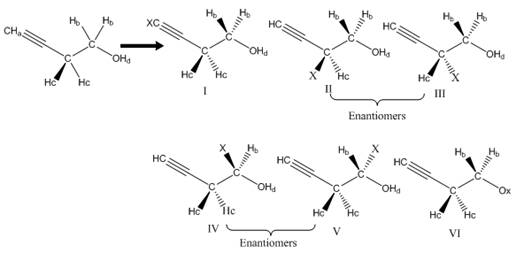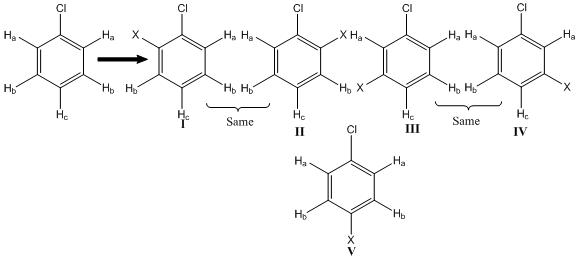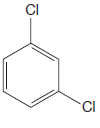
Concept explainers
(a)
Interpretation:
How many chemically distinct H atoms are in the given molecule is to be determined.
Concept introduction:
Sometimes, it is not immediately obvious whether certain hydrogen atoms in a molecule are chemically distinct. In such cases, the chemical distinction test is used. Chemical distinction test is a test in which the complete structure of the molecule is to be drawn in which and only the hydrogen atom is replaced by an imaginary “X” atom. There should be one X-substituted molecule for each hydrogen atom being tested. If the chemical distinction test yields enantiomers, then the corresponding hydrogen atoms are said to be enantiotopic. If the test yields diastereomers, then the corresponding hydrogen atoms are said to be diastereotopic.
Answer to Problem 16.8P
There are two types of chemically distinct H atoms in the given molecule.
Explanation of Solution
The given molecule is:

There are five H atoms in the above compound. These H atoms are not easily identified whether they are distinct or similar. Thus, the chemical distinction test is used here.
All H atoms in the compound are replaced by “X”; all possible structures are as shown below:

Molecules I and II are enantiomers i.e. mirror images of each other. According to chemical distinction test, these H atoms are not chemically distinct. Molecules I/II and III are constitutional isomers, these H atoms are chemically distinct. Therefore, there are two distinct types of protons, one for
Number of chemically distinct H atoms in the given molecule is determined using a chemical distinction test.
(b)
Interpretation:
How many chemically distinct H atoms are in the given molecule is to be determined.
Concept introduction:
Sometimes, it is not immediately obvious whether certain hydrogen atoms in a molecule are chemically distinct. In such cases the chemical distinction test is used. Chemical distinction test is a test in which the complete structure of the molecule is to be drawn in which and only the hydrogen atom is replaced by an imaginary “X” atom. There should be one X-substituted molecule for each hydrogen atom being tested. If the chemical distinction test yields enantiomers, then the corresponding hydrogen atoms are said to be enantiotopic. If the test yields diastereomers, then the corresponding hydrogen atoms are said to be diastereotopic.
Answer to Problem 16.8P
There are four types of chemically distinct H atoms in the given molecule.
Explanation of Solution
The given molecule is:

There are six H atoms in the above compound. These H atoms are not easily identified as distinct or similar. Thus, the chemical distinction test is used here.
All H atoms in the compound are replaced by “X”; all possible structures are as shown below:

Molecules I, II/III, IV/V, and VI are constitutional isomers. According to chemical distinction test, these H atoms are chemically distinct. Molecules II and III also IV and V are enantiomers; these H atoms are not chemically distinct according to the test. Thus, there are total four types of chemically distinct protons in the given molecule b.
Number of chemically distinct H atoms in the given molecule are determined using chemical distinction test.
(c)
Interpretation:
How many chemically distinct H atoms are in the given molecule is to be determined.
Concept introduction:
Sometimes, it is not immediately obvious whether certain hydrogen atoms in a molecule are chemically distinct. In such cases the chemical distinction test is used. Chemical distinction test is a test in which the complete structure of the molecule is to be drawn in which and only the hydrogen atom is replaced by an imaginary “X” atom. There should be one X-substituted molecule for each hydrogen atom being tested. If the chemical distinction test yields enantiomers, then the corresponding hydrogen atoms are said to be enantiotopic. If the test yields diastereomers, then the corresponding hydrogen atoms are said to be diastereotopic.
Answer to Problem 16.8P
There are three types of chemically distinct H atoms in the given molecule.
Explanation of Solution
The given molecule is:

There are five H atoms in the above compound. These H atoms are not easily identified as distinct or similar. Thus, the chemical distinction test is used here.
All H atoms in the compound are replaced by “X”; all possible structures are as shown below:

Molecules I and II, and also III and IV are the same molecules. Molecules I/II, III/IV, and V are consititutional isomers. These H atoms are distinct according to the chemical distinction test. Therefore, there are three types of chemically distinct H atoms in the given molecule c.
Number of chemically distinct H atoms in the given molecul, are determined using chemical distinction test.
(d)
Interpretation:
How many chemically distinct H atoms are in the given molecule is to be determined.
Concept introduction:
Sometimes, it is not immediately obvious whether certain hydrogen atoms in a molecule are chemically distinct. In such cases the chemical distinction test is used. Chemical distinction test is a test in which the complete structure of the molecule is to be drawn in which and only the hydrogen atom is replaced by an imaginary “X” atom. There should be one X-substituted molecule for each hydrogen atom being tested. If the chemical distinction test yields enantiomers, then the corresponding hydrogen atoms are said to be enantiotopic. If the test yields diastereomers, then the corresponding hydrogen atoms are said to be diastereotopic.
Answer to Problem 16.8P
There are three types of chemically distinct H atoms in the given molecule.
Explanation of Solution
The given molecule is:

There are four H atoms in the above compound. These H atoms are not easily identified s distinct or similar. Thus, the chemical distinction test is used here.
All H atoms in compound are replaced by “X”; all possible structures are as shown below:

Molecules II and III are the same molecule. Molecules I, II/III and IV are constitutional isomers. According to the chemical distinction test, these H atoms are distinct. Therefore, there are three types of chemically distinct H atoms in the given molecule d.
Number of chemically distinct H atoms in the given molecule is determined using the chemical distinction test.
(e)
Interpretation:
How many chemically distinct H atoms are in the given molecule is to be determined.
Concept introduction:
Sometimes, it is not immediately obvious whether certain hydrogen atoms in a molecule are chemically distinct. In such cases the chemical distinction test is used. Chemical distinction test is a test in which the complete structure of the molecule is to be drawn in which and only the hydrogen atom is replaced by an imaginary “X” atom. There should be one X-substituted molecule for each hydrogen atom being tested. If the chemical distinction test yields enantiomers, then the corresponding hydrogen atoms are said to be enantiotopic. If the test yields diastereomers, then the corresponding hydrogen atoms are said to be diastereotopic.
Answer to Problem 16.8P
There is one type of chemically distinct H atom in the given molecule.
Explanation of Solution
The given molecule is:

There are four H atoms in the above compound. These H atoms are not easily identified as distinct or similar. Thus, the chemical distinction test is used here.
All H atoms in compound are replaced by “X”; all possible structures are as shown below:

All molecules, I, II, III and IV are same. These H atoms are not distinct according to the chemical distinction test. Therefore, there is only one type of chemically distinct H atoms in the given molecule e.
Number of chemically distinct H atoms in the given molecule is determined using chemical distinction test.
(f)
Interpretation:
How many chemically distinct H atoms are in the given molecule is to be determined.
Concept introduction:
Sometimes, it is not immediately obvious whether certain hydrogen atoms in a molecule are chemically distinct. In such cases the chemical distinction test is used. Chemical distinction test is a test in which the complete structure of the molecule is to be drawn in which and only the hydrogen atom is replaced by an imaginary “X” atom. There should be one X-substituted molecule for each hydrogen atom being tested. If the chemical distinction test yields enantiomers, then the corresponding hydrogen atoms are said to be enantiotopic. If the test yields diastereomers, then the corresponding hydrogen atoms are said to be diastereotopic.
Answer to Problem 16.8P
There are three types of chemically distinct H atoms in the given molecule.
Explanation of Solution
The given molecule is:

There are five H atoms in the above compound. These H atoms are not easily identified as distinct or similar. Thus, the chemical distinction test is used here.
All H atoms in compound are replaced by “X”; all possible structures are as shown below:

Molecules I and II, and also III and IV are the same molecule. Molecules I/II and III/IV are constitutional isomers. According to the chemical distinction test, these H atoms are chemically distinct. Therefore, there are three types of chemically distinct H atoms, two from the
Number of chemically distinct H atoms in the given molecule is determined using chemical distinction test.
Want to see more full solutions like this?
Chapter 16 Solutions
Organic Chemistry: Principles And Mechanisms: Study Guide/solutions Manual (second)
- Speaking of composite materials, indicate the correct option:(A). Composite materials can only be: metal-polymer or polymer-polymer.(B). Composite materials can be made up of particles, but not fibers or sheets.(C). When the reinforcing particles are uniformly distributed in a composite material, there may be a greater tendency for it to have isotropic properties.(D). None of the above is correct.arrow_forwardIf we are talking about viscoelastic modulus or viscoelastic relaxation modulus in polymers, indicate the correct option.(A). It reports the variation of elastic behavior as a function of time.(B). It is only useful for defining its glass transition temperature.(C). It only allows us to define the polymer degradation temperature.(D). Neither option is correct.arrow_forwardWhen natural light falls perpendicularly on a material A, it has a reflectivity of 0.813%. Indicate the value of the refractive index.arrow_forward
- In piezoelectricity and piezoelectric ceramics, one of the following options is false:(A). Piezoelectricity allows an electrical signal to be transformed into a mechanical one.(B). PbZrO3 is a well-known piezoelectric ceramic.(C). Piezoelectricity and ferroelectricity in general have no relationship.(D). One of the applications of piezoelectricity is sonar.arrow_forward(30 MARKS) Give the major product(s ) formed including relevant stereochemistry or the complete reaction conditions for the following reactions. More than one step may be required for each reaction arrow, in which case the steps must be numbered 1), 2) etc. (2 marks each box) h) i) h) OH i) HO H3PO4, heat 2 Brarrow_forwardNonearrow_forward
- Indicate which option is false(A). Resistivity has a residual component and a thermal component.(B). In some materials resistivity increases with T and in others it decreases.(C). In insulating materials, resistivity is very low.arrow_forwardIn ceramic materials, in relation to polymorphism, the same substance crystallizes differently when external conditions vary. Is this correct?arrow_forwardIndicate the type of bond that is considered to be a hydrogen bond.(A). Permanent dipole-dipole interaction between polar molecules.(B). Mixed ionic-covalent bond.(C). Principal interatomic bond(D). Van del Waals forces.arrow_forward
- Retro aldol: NaOH H₂O H NaOH & d H₂O Harrow_forwardDraw the product of the reaction shown below. Ignore inorganic byproducts. H conc. HBr Drawing Qarrow_forwardCalculate the atomic packing factor of diamond knowing that the number of Si atoms per cm3 is 2.66·1022 and that the atomic radii of silicon and oxygen are, respectively, 0.038 and 0.117 nm.arrow_forward
 Organic Chemistry: A Guided InquiryChemistryISBN:9780618974122Author:Andrei StraumanisPublisher:Cengage Learning
Organic Chemistry: A Guided InquiryChemistryISBN:9780618974122Author:Andrei StraumanisPublisher:Cengage Learning

